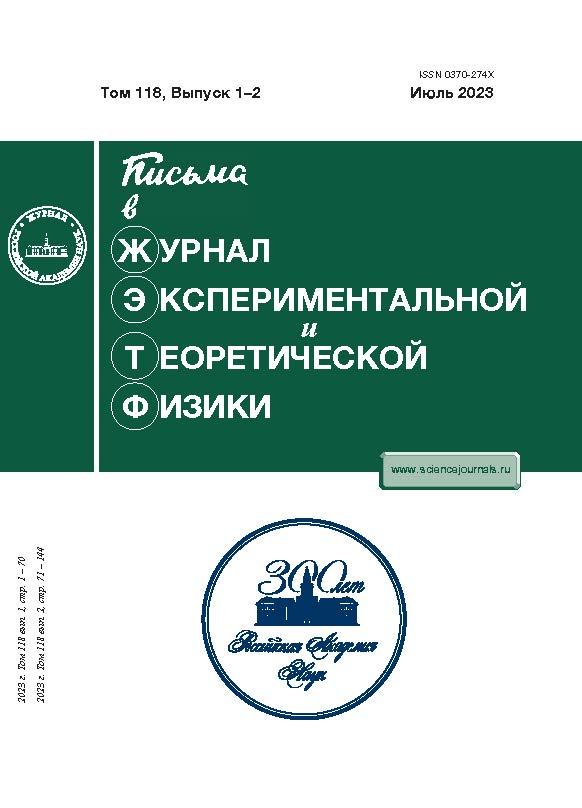Sharp Focusing of an Atomic Beam with the Doppler and Sub-Doppler Laser Cooling Mechanisms in a Two-Dimensional Magneto-Optical Trap
- Autores: Bykova D.V.1,2, Afanas'ev A.E.1, Balykin V.I.1
-
Afiliações:
- Institute of Spectroscopy, Russian Academy of Sciences
- National Research University Higher School of Economics
- Edição: Volume 118, Nº 1-2 (7) (2023)
- Páginas: 7-13
- Seção: Articles
- URL: https://cardiosomatics.ru/0370-274X/article/view/663087
- DOI: https://doi.org/10.31857/S1234567823130037
- EDN: https://elibrary.ru/FZJDGK
- ID: 663087
Citar
Texto integral
Resumo
The focusing of an atomic beam with the use of a two-dimensional magneto-optical trap in order to increase the number of atoms in the region of their laser cooling and localization near an atom chip is discussed. Two regimes of the interaction of atoms with a focusing laser field are considered: (i) the Doppler interaction regime, which occurs at small detunings of the laser field from the atomic resonance, and (ii) the sub-Doppler interaction regime, which occurs at large detunings of the laser field from the atomic resonance. The efficiency of focusing in the first case is low because of the momentum diffusion. It has been shown that the momentum diffusion in the sub-Doppler cooling mechanism is insignificant and, as a result, the broadening of the transverse velocity distribution of atoms is small. The sharp focusing of the atomic beam is possible in this interaction regime.
Sobre autores
D. Bykova
Institute of Spectroscopy, Russian Academy of Sciences;National Research University Higher School of Economics
Email: afanasiev@isan.troitsk.ru
Troitsk, Moscow, 108840 Russia;Moscow, 101000 Russia
A. Afanas'ev
Institute of Spectroscopy, Russian Academy of Sciences
Email: afanasiev@isan.troitsk.ru
Troitsk, Moscow, 108840 Russia
V. Balykin
Institute of Spectroscopy, Russian Academy of Sciences
Autor responsável pela correspondência
Email: afanasiev@isan.troitsk.ru
Troitsk, Moscow, 108840 Russia
Bibliografia
- S. Wildermuth, P. Kr¨uger, C. Becker, M. Brajdic, S. Haupt, A. Kasper, R. Folman, and J. Schmiedmayer, Phys. Rev. A 69, 030901 (2004).
- V. Singh, V.B. Tiwari, K.A.P. Singh, and S.R. Mishra, J. Mod. Opt. 65(21), 2332 (2018).
- A.E. Afanasiev, D.V. Bykova, P. I. Skakunenko, and V. I. Balykin, JETP Lett. 115, 509 (2022).
- A.E. Afanasiev, A. S. Kalmykov, R.V. Kirtaev, A.A. Kortel, P. I. Skakunenko, D.V. Negrov, and V. I. Balykin, Opt. Laser Technol. 148, 107698 (2022).
- V. I. Balykin, JETP Lett. 66, 349 (1997).
- Z.T. Lu, K. L. Corwin, M. J. Renn, M.H. Anderson, E.A. Cornell, and C.E. Wieman, Phys. Rev. Lett. 77(16), 3331 (1996).
- P.N. Melentiev, P.A. Borisov, S.N. Rudnev, A.E. Afanasiev, and V. I. Balykin, JETP Lett. 83(1), 14 (2006).
- A.M. Steane, M. Chowdhury, and C. J. Foot, J. Opt. Soc. Am. B 9(12), 2142 (1992).
- S. Chang, T.Y. Kwon, H. S. Lee, and V.G. Minogin, Phys. Rev. A 60, 3148 (1999).
- C. Salomon, J. Dalibard,W.D. Phillips, A. Clairon, and S. Guellati, EPL 12, 683 (1990).
- S.A. Hopkins, PhD thesis, The Open University, Milton Keynes, England (1996).
- V. S. Letokhov and V.G. Minogin, Phys. Rep. 73, 1 (1981).
- S. Chang and V.G. Minogin, Phys. Rep. 365, 65 (2002).
- J.W. Jun, S. Chang, T.Y. Kwon, H. S. Lee, and V.G. Minogin, Phys. Rev. A 60, 3960 (1999).
Arquivos suplementares










